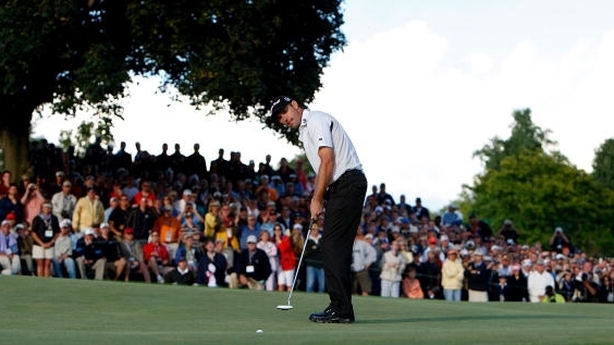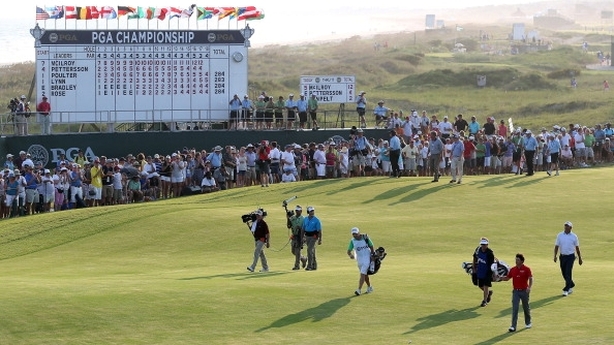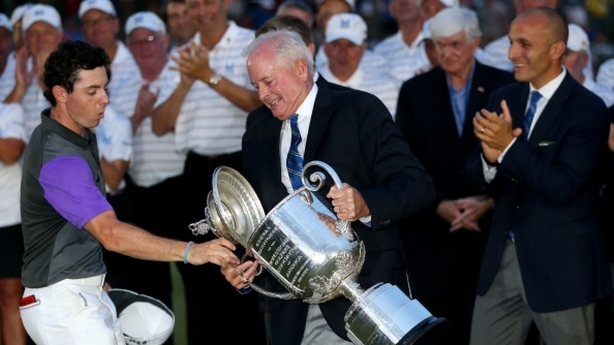For decades, the PGA Championship was the most inhospitable major tournament in the US as far as European golfers were concerned.
Whereas golfers from this side of the Atlantic enjoyed a remarkable winning streak at Augusta in the late 80s and early 90s - between 1988 and 1996, European golfers won seven green jackets - the Wanamaker Trophy remained largely the preserve of native players.
Indeed, some of the winners were, at the time of their victory, quite obscure to European audiences - John Daly, Rich Beem, Shaun Micheel.
The sense thus created was that this was a tournament for Americans, invariably played on luscious, sun-drenched parkland courses, and more likely to be won by a Tin Cup slugger from Idaho than a household name on the European Tour.
That's all changed now. Since Padraig Harrington's victory at Oakland Hills in 2008, the winners' enclosure at the PGA has had a more internationalist feel with non-US players accounting for six of the last nine winners.
The sense thus created was that this was a tournament for Americans, invariably played on luscious, sun-drenched parkland courses, and more likely to be won by a Tin Cup slugger from Idaho than a household name on the European Tour.
2008, Oakland Hills
Padraig Harrington's third major win in Michigan in 2008 bridged an awfully long gap for golfers on this side of the pond.
A very, very long gap.
In fact, the last European golfer to win the PGA Championship before Harrington lost the sight in his left eye in World War I.
Scotsman Tommy Armour, one of the deadliest machine gunners on the Allied side, survived the war and emigrated to America, acquiring dual citizenship later on. Among his haul of three majors was the 1930 PGA Championship, then played off on a matchplay format.
Anything was possible for Padraig Harrington in the summer of 2008. He had crawled over the line to win his first major at Carnoustie in 2007.

As often happens when a player gets one major under his belt success flows much easier. Harrington retained his Open Championship in 2008 in far more relaxed circumstances at Royal Birkdale.
And by August 2008, he was lethal when in contention, hungrily stalking his mentally vulnerable prey in Faldo-esque fashion.
His long game was in rag order in the opening two days but he remained in touch in highly congested field. His score of +5 left him six shots adrift of the lead.
A round of 66 on the Saturday catapulted him up the leaderboard, leaving him in tied-4th and three strokes behind the outright leader Ben Curtis.
While the likes of JB Holmes faltered, Harrington and Sergio Garcia came to the fore, just as it had been at Carnoustie 13 months earlier.
Garcia made the early running and appeared set to avenge his playoff defeat in Scotland but Harrington's putter was far too hot to be denied.
2012, Kiawah Island
A record winning margin in the competition and Hollywood's finest might have won by more had it not been for a violent wobble in Round 2.
The course at Kiawah Island was best known to Irish golf fans as the site of the 1991 Ryder Cup when the Americans won it back after a gap of eight years with the narrowest of victories and Seve Ballesteros and Jose Olazabal played out a rancorous match with Paul Azinger and Chip Beck.
But McIlroy alone ripped the course to shreds during August 2012, hitting 67, 75, 67, 66 across the four days.

After imploding on the final day of the 2011 Masters, McIlroy cantered to victory in the next major, the 2011 US Open at the Congressional, winning by eight shots and setting the lowest under par total in the history of the tournament.
His second major tournament victory involved the breaking of another record. McIlroy led by a relatively modest three strokes after a second round 67.
But he sped away from the field in the final round, eventually making it a record winning margin thanks to a closing flourish. He needed only 24 putts en route to a final round 66.
Nicklaus won by seven strokes at Oak Hill in 1980 but McIlroy drained a 20 foot putt on the 72nd hole to top that 32-year old record.
"The new ruler of the game is golf is Rory McIlroy," announced US commentator Jim Nantz (best known over here for his log cabin performances after the Masters alongside his 'good friend' Hootie Johnson).
Others have risen to contest McIlroy for that accolade in the last couple of years but he had unquestionably established himself as the world's best by the end of 2012.
2014, Valhalla
McIlroy became the first player to win the PGA Championship and the Open Championship in the one year since... Padraig Harrington.
McIlroy's fourth and latest major championship win came during his late 2014 renaissance. He endured a miserable 2013, winning only the Australian Open.
In classic Rory fashion, a flick was switched sometime in the summer of 2014 and suddenly all was sweetness and light on the golf course once more - we shall leave speculation about his love life to the magazines.

He won at Wentworth in May, claimed his first ever Open Championship at Royal Liverpool in July, and added the WGC Bridgestone Invitational at Firestone at the beginning of August.
The following week, his hot streak continued with a one-shot win at Valhalla. Not quite a wire-to-wire victory as he only nosed ahead on the Friday but he was menacingly close to the summit of the leaderboard from the get-go.
In contrast to 2012, when he stretched out his lead on the final day, in Kentucky he had to fend off a close challenge from a star-studded field including Phil Mickelson, Rickie Fowler and Henrik Stenson.
He would seal victory with a messy par five on the 72nd hole to prevail from Mickelson by a shot.


